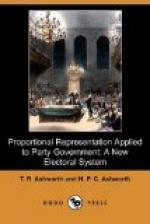It has also been objected that a Ministerialist candidate, say, might stand as an Oppositionist, if the votes of the Opposition candidates were more split up and it was likely to require less votes for election in that party. This is a rather fantastic suggestion. The candidate in question would have to declare himself in favour of a number of things which he would oppose immediately he was elected. If not, he would have to openly declare his intention, but that could easily be made illegal. In any case there would be very little gained, and there is further the risk that, if defeated, all his votes would count to the Opposition.
Another possible objection is that too many candidates might stand, since it is to the interest of each party to get all the support it can. But candidates are not likely to stand to oblige the party or when there is no chance of being elected. It is quite possible that, in a country already split up into numerous groups, the groups would refuse to act together, and that each group would nominate its own list. This is an extreme assumption, and certainly would not happen in British countries. And there would be a constant incentive to the groups to compromise, since a combination can return its candidates.
We hope now to have at least established the fact that the organization of a democracy into two coherent parties—a majority and a minority—is vitally connected with the electoral machinery. We do not claim that the method we have proposed will induce a people to vote on true party lines all at once, for human nature cannot be changed in a day; but we do confidently assert that it will greatly accelerate that desirable result, and will tend to give effect to the principles of organization and responsible leadership.




